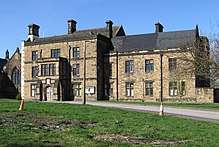Lord James Cavendish (MP for Derby)
Lord James Cavendish FRS (bef. 1707 – 14 December 1751) of Staveley Hall, Derbyshire was a British Whig politician who sat in the English House of Commons between 1701 and 1707 and in the British House of Commons between 1707 and 1742.


Early life
Cavendish was the third son of William Cavendish, 1st Duke of Devonshire and his wife Lady Mary Butler, daughter of James Butler, 1st Duke of Ormonde. He travelled abroad in France and Italy from 1696 to 1698 and attended Padua University in 1697.
Career
Cavendish was returned as Member of Parliament for Derby in both the general elections of 1701. He did not stand in 1702, but was elected in a contest at the 1705 English general election, defeating the sitting Tories. He voted for the Court candidate in the contest for Speaker on 25 October 1705 and supported the Court on the regency bill proceedings on 18 February 1706. He was returned unopposed for Derby at the 1708 general election. He acted as a teller on the petition of defeated Whig candidates at Coventry and later voted for the naturalization bill in 1709 and for the impeachment of Dr Sacheverell in 1710. At the 1710 British general election, he was defeated in a contest for Derby and decided not to stand in 1713.[1]
Cavendish was returned as MP for Derby at the 1715 general election and voted for the septennial bill in 1716 and the repeal of the Occasional Conformity and Schism Acts in 1719. He was returned unopposed at the 1722 and 1727 general elections. In the latter parliament he took an independent line, and voted against the Government on the Hessians 1730, the army 1732, and the repeal of the Septennial Act 1734, but with them on the civil list 1729, and the excise bill 1733. He was elected in a contest at Derby in 1734 and voted for the place bill 1740. He was returned unopposed at the 1741 general election, but on 8 March 1742 he vacated his seat to take up the post of Auditor of Foreign Accounts or Imposts in Ireland. He did not stand again for Derby at the ensuing by-election.[2]
Death and legacy
Cavendish married with £8,000 Anne Yale (died 1734), daughter of Elihu Yale on 6 July 1708. They had two children:
- William Cavendish (died July 1751) who married Barbara Chandler. They had no children, and his widow married secondly John Fitzwilliam
- Elizabeth Cavendish, married Richard Chandler in February 1722
As his only son predeceased him by a few months, his heir was his son-in-law Richard Chandler, who subsequently adopted the name of Cavendish.[3]
References
- "CAVENDISH, Lord James (c.1678-1751), of Staveley, Derbys. and Latimer, Bucks". History of Parliament Online (1690-1715). Retrieved 7 October 2018.
- "CAVENDISH, Lord James (aft.1673-1751), of Staveley, Derbys". History of Parliament Online (1715-1754). Retrieved 7 October 2018.
- Deed Poll Office: Private Act of Parliament 1751 (25 Geo. 2). c. 28
| Parliament of England | ||
|---|---|---|
| Preceded by Lord Henry Cavendish George Vernon |
Member of Parliament for Derby 1701–1702 With: Sir Charles Pye 1701 John Harpur 1701–1702 |
Succeeded by John Harpur Thomas Stanhope |
| Preceded by John Harpur Thomas Stanhope |
Member of Parliament for Derby 1705–1707 With: Sir Thomas Parker |
Succeeded by Parliament of Great Britain |
| Parliament of Great Britain | ||
| Preceded by Parliament of England |
Member of Parliament for Derby 1707–1710 With: Sir Thomas Parker 1707–1710 Richard Pye 1710 |
Succeeded by Sir Richard Levinge, Bt John Harpur |
| Preceded by Edward Mundy Nathaniel Curzon |
Member of Parliament for Derby 1715–1742 With: William Stanhope 1715–1722, 1727–1730 Thomas Bayley 1722–1727 Charles Stanhope 1730–1736 John Stanhope 1736–1742 |
Succeeded by John Stanhope Viscount Duncannon |